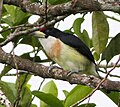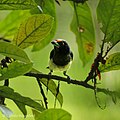| Capito | |
|---|---|
 | |
| female Black-spotted barbet (C. niger) | |
| Scientific classification | |
| Kingdom: | Animalia |
| Phylum: | Chordata |
| Class: | Aves |
| Order: | Piciformes |
| Family: | Capitonidae |
| Genus: | Capito Vieillot, 1816 |
| Type species | |
| "Tamatia à tête et gorge rouge" Buffon =Bucco niger Müller, PLS, 1776 | |
| Species | |
11, see text | |
Capito is a genus of birds in the family Capitonidae. They are found in humid forests in South America, with a single species extending into eastern Panama. Slightly larger than the members of the genus Eubucco , members of the genus Capito are all sexually dimorphic and thickset, and have stubby pale bills that often are tipped black. With the exception of the somewhat aberrant scarlet-crowned barbet, black, red, orange, yellow and white are the dominating colours in their plumage, and males have at least partially black backs. Typically seen singly or in pairs, they are primarily frugivorous, but also take arthropods.

















